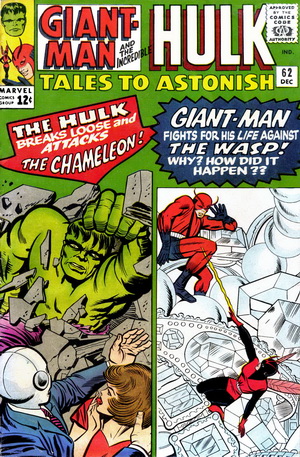
Published: December, 1964
“Giant-Man Versus the Wonderful Wasp!”
Script: Stan Lee
Pencils: Carl Burgos
Inks: Dick Ayers
Letters: Art Simek
THE POWER OF IMPERSONATION
We begin with Giant-Man facing a new villain…if you want to call him a “villain.” Second-Story Sammy is actually little more than a second-class thug, who wears a hat and bow tie while burglarizing second-story apartments. This career is going nowhere. Clearly Sammy needs a new angle, a makeover, and he gets one when he witnesses bio-chemist Henry Pym committing the unforgiveable error of using too potent an additive in his experiment. An explosion throws Pym across the room, knocking him out.
During the explosion, a business card drops from the table to the floor. (Because, as everyone knows, no bio-chemist worth his sodium chloride could possibly complete a potentially explosive experiment without his business card being right there…)
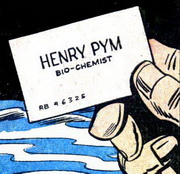 Sammy picks up the card, discovers it’s for Henry Pym, Bio-Chemist, and correctly jumps to the conclusion that the unconscious man in the Giant-Man monkey suit must BE Henry Pym. (Hey, folks, we’ve only got 12 pages to tell this story, can’t waste a whole lot of time trying to get things to make sense.)
Sammy picks up the card, discovers it’s for Henry Pym, Bio-Chemist, and correctly jumps to the conclusion that the unconscious man in the Giant-Man monkey suit must BE Henry Pym. (Hey, folks, we’ve only got 12 pages to tell this story, can’t waste a whole lot of time trying to get things to make sense.)
So at this point, I’m feeling somewhat deflated about the potential for this story, but then something happens that’s both amazing and disturbing. When Sammy puts on the Giant-Man suit, he finds he has ALL the powers that Hank has when wearing the suit. He is, effectively, Giant-Man.
Which leads me to ask the question: how dangerous is it, to have that much power in something that can be stolen?
THE EVENING GOWN COMPETITION
Let’s quickly review the other Avengers as they slip into their superhero attire. Captain America also has a suit, but the power is not in the suit, it’s in his chemically altered and well-trained body. As Russ rightly points out, Steve Rogers is Captain America, even in his pajamas. Yes, he’s got that shield, but any criminal stealing it would not be able to wield it as a weapon, unless he also possessed the same conditioning and strength as Steve Rogers.
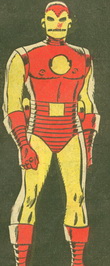
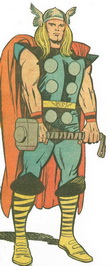 Iron Man has a suit (and you’ll notice for this discussion, I can’t bring myself to call it a “costume”). Iron Man’s suit also has a lot of power, arguably more than Pym’s expanding leotard and cybernetic helmet. Could that suit be stolen and manipulated for evil purposes? Perhaps. I haven’t seen that storyline, but I surmise that a villain would need the brilliant brain and technical know-how of a Tony Stark to make the suit perform effectively. (Of course, that’s not out of the realm of possibility, so…hmmm…I guess I’ll have to wait and see.)
Iron Man has a suit (and you’ll notice for this discussion, I can’t bring myself to call it a “costume”). Iron Man’s suit also has a lot of power, arguably more than Pym’s expanding leotard and cybernetic helmet. Could that suit be stolen and manipulated for evil purposes? Perhaps. I haven’t seen that storyline, but I surmise that a villain would need the brilliant brain and technical know-how of a Tony Stark to make the suit perform effectively. (Of course, that’s not out of the realm of possibility, so…hmmm…I guess I’ll have to wait and see.)
As for Thor, he’s a god, his power cannot be stolen. Except perhaps by another god, like Loki, who can hypnotize and neutralize him, but that’s not the same as stealing his power. Thor has his hammer, which no one but he can pick up, so….no problem there.
Conclusion? Of all the superheroes I’ve met so far, Giant-Man is the most vulnerable to attack and impersonation. And that’s a real problem, for him, and the world he lives in. As such, Pym would be wise to jealously guard his secret identity. And of course, the conceit of this story is that he actually DOES have a policy of keeping his Giant-Man identity a secret. Except…he doesn’t.
Even if we forget for a moment that at the end of this story, he invites members of THE PRESS up to Henry Pym’s lab, Giant-Man has never been super-careful about his secret identity. For instance, in Tales to Astonish #55, Giant-Man and Wasp hold a fan club meeting…IN HENRY PYM’S LABORATORY! Hello! Does this strike anyone as odd? It’s apparently common knowledge, if not that Pym and Giant-Man are the same person, that they are at least buddies. Any villain who wanted to find out more about Giant-Man would only have to corner mild-mannered Pym in a dark alley and make him talk.
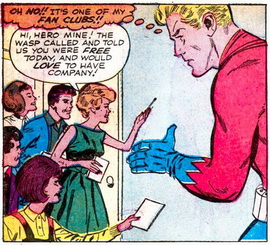 Now, as if this wasn’t enough, in Tales to Astonish #54, Pym receives a surprise visit from his fan club at his lab, while he’s wearing his Giant-Man costume…without his mask! So, everyone in his fan club now knows that the giant man inside the Giant-Man suit IS, in fact, Henry Pym.
Now, as if this wasn’t enough, in Tales to Astonish #54, Pym receives a surprise visit from his fan club at his lab, while he’s wearing his Giant-Man costume…without his mask! So, everyone in his fan club now knows that the giant man inside the Giant-Man suit IS, in fact, Henry Pym.
One more? In Tales to Astonish #58, Captain America actually STOPS BY Pym’s lab to deliver a message to Giant-Man. As we all know, there’s a solemn pact among the Avengers that they never reveal their real identities to each other. But somehow, Cap had no problem knowing exactly where to find Giant-Man. (Maybe he’s been dating a talkative gal from Giant-Man’s fan club?)
There may be other examples, but I’ve made my point. Giant-Man’s secret identity…well…not so secret. But the funny part is that brilliant scientist Pym honestly believes it is! Because, at the end of the story, he feels compelled to use a memory-loss serum on Sammy to make him forget everything that’s happened.
 Wiping Sammy’s memory clean is actually a good idea, though not for the preservation of Giant-Man’s secret identify. The real reason should be so Sammy doesn’t get drunk at the bar and blab to everyone he knows that by stealing Giant-Man’s suit, he got to BE Giant-Man for a day. That’s a much bigger and more dangerous issue for Giant-Man than his supposed “secret identity.”
Wiping Sammy’s memory clean is actually a good idea, though not for the preservation of Giant-Man’s secret identify. The real reason should be so Sammy doesn’t get drunk at the bar and blab to everyone he knows that by stealing Giant-Man’s suit, he got to BE Giant-Man for a day. That’s a much bigger and more dangerous issue for Giant-Man than his supposed “secret identity.”
So why does the story not go there? Theory: Maybe Pym is aware that he has a problem with his “one size fits all” suit, but is embarrassed to confess to Jan that he doesn’t know how to fix it. There could be a lot more going on behind the scenes than the writers are letting us in on. Or, more likely, they simply haven’t put a dollar’s worth of thought into a 12-cent, 12-page story.
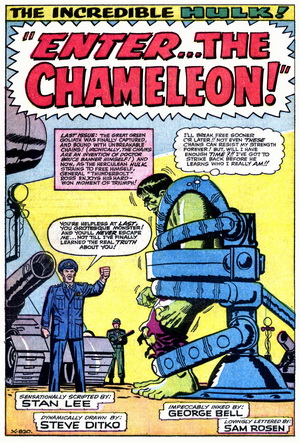 “Enter…the Chameleon!”
“Enter…the Chameleon!”
Script: Stan Lee
Pencils: Steve Ditko
Inks: George Bell
Letters: Sam Rosen
BANNER’S SUPREME SECRET
But let’s move on to Hulk now, because Bruce Banner also has a secret identity, but like Thor, there’s no way anyone’s stealing his thunder by stumbling upon a pill or portion or wundersuit. And unlike fellow scientist Pym, Banner’s survival and freedom is absolutely dependent upon no one finding out that he moonlights as Mr. Mean and Green. In Banner’s case, the secret really IS supreme, and for that reason I might be able to forgive him for what at first appear to be misplaced priorities.
We start on the splash, with Hulk imprisoned in unbreakable chains, anxiously lamenting that he must make every effort to break free before General Ross learns “who I really AM!!” Then, as soon as Banner is Banner once again, practically the first words out of his mouth are a relieved “I don’t think anyone saw my transformation!”
At the end of the story, when the blast of the gamma bomb causes Hulk to turn back, Banner’s first thought is how lucky he is there’s so much smoke that nobody saw him transform. Not “I’m grateful I’m still alive,” or “Thank God nobody was killed by the bomb!” No, uppermost in his mind is the preservation of his secret identity.
THE CRAFTY CHAMELEON
But Banner’s secret identity is only a small portion of the masquerading going on here. The Chameleon serves as the villain of this piece, and though in the past I’ve been less than impressed, slowly I’m beginning to appreciate his charms.
Chameleon is sent on a mission by a mysterious leader, named…wait for it…The Leader. His objective is to find out what happened to the agent sent to General Ross’s missile base in Tales to Astonish #61, but that little fact is completely beside the point. The point is that it’s the Chameleon, so now we know we’re off on a roller coaster ride of nothing being what it seems.
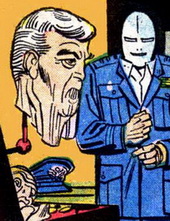 Arriving at the base, Chameleon impersonates General Ross in order to make Hulk his ally. The clueless soldiers leave the commandeering “General” alone with the beast. Hulk is uncooperative, of course, but that doesn’t matter, because when Chameleon/Ross steps away for a moment, Hulk transforms back to Banner and escapes.
Arriving at the base, Chameleon impersonates General Ross in order to make Hulk his ally. The clueless soldiers leave the commandeering “General” alone with the beast. Hulk is uncooperative, of course, but that doesn’t matter, because when Chameleon/Ross steps away for a moment, Hulk transforms back to Banner and escapes.
Drats! But Chameleon isn’t beaten yet. Deciding he may not be able to fulfill his mission of finding out about the missing agent, he settles on Plan B, stealing secrets from one of America’s greatest atomic scientists. To do this, he captures and impersonates Banner, locating not only the plans, but also an actual GAMMA BOMB Banner just happens to have laying around in his office.
All seems to be going well for Chameleon, but then…enter Betty. A mere girl. It takes her all of 30 seconds to figure out that the guy who looks like Bruce is not really her sweetie-pie.  The narrator puts this down to “an intuition, which only females seem to have.” Which makes me wonder if Stan is implying that all women possess a mild yet innate level of superpowers.
The narrator puts this down to “an intuition, which only females seem to have.” Which makes me wonder if Stan is implying that all women possess a mild yet innate level of superpowers.
A short time later, “Banner” hides an unconscious Betty in a “rocket speed-velocity test sled,” then runs off, hoping to deliver the gamma grenade to the Leader and become “the most important spy of all!”
The real Banner has other plans, though, and having transformed to Hulk, pursues Chameleon, who is forced to use the gamma bomb, which of course has no impact on someone of Hulk’s stature. Chameleon escapes with nothing to show for his efforts, and Banner disappears into the smoke, hoping he can change clothes before Talbot “puts two and two together and realizes who the Hulk really IS!”
Well, not much chance of anyone putting two and two together any time soon. What fun would that be? I feel confident I’ll continue to enjoy the amusements of masquerade in Marvel Comics for a long time to come.
JUSTICE ISN’T BLIND, SHE’S BLINDFOLDED
And now, for something completely different: I have a little problem with the way justice is handed out in both stories.
In the Hulk feature, the charges against Banner are quickly dismissed when Betty swears he wasn’t the one who kidnapped her and set off that bomb. Ross reveals that he still has suspicions, but what do you expect? He’s an over-protective father. The important point is that based solely on the testimony of Banner’s GIRLFRIEND, they’re not even going to investigate the matter further. Is this any way to run a military, with a ferocious green monster running about? It’s all resolved too easily.
But that’s nothing compared to the way the Giant-Man story concludes.
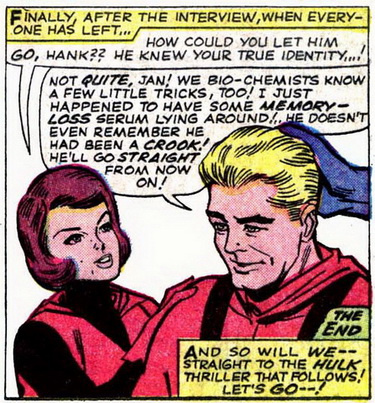
Okay. Where shall I begin? How about… “just happened to have some memory-loss serum lying around”? Between Banner with gamma bombs carelessly strewn about his office, and Pym’s potent memory-loss serum, I’d say our scientist boys are awfully careless with their toys.
But that’s not the worst of it. I have to wonder: If indeed Pym has a memory serum that can make criminals forget they’ve ever been criminals, why doesn’t he share this incredible concoction with the justice system? Jail wardens could simply pop a drop of the potion in every inmate’s plate of beans, wipe their slates clean, empty the jails and solve all of society’s ills overnight.
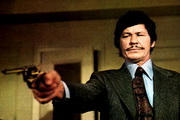 Wouldn’t that be wonderful? Or…maybe not. Because even though criminals would no longer remember they’ve been criminals, there would still be victims demanding justice. Does that not count for anything?
Wouldn’t that be wonderful? Or…maybe not. Because even though criminals would no longer remember they’ve been criminals, there would still be victims demanding justice. Does that not count for anything?
I guess not, if you happen to be Henry Pym, Bio-Chemist. He has no problem taking upon himself the roles of judge and jury, and never mind executioner, because he’ll simply pardon wrongdoers, whenever it suits his own purposes (i.e. – keeping his secret, which we’ve already determined, is no secret at all). He’s like a mad scientist performing brain surgery on people without consent.
Apparently, Pym has decided that one of the perks of being a superhero is that he gets to decide who has to pay and who gets a free pass. I’m concerned about any one person having all this power, especially if that person is self-absorbed and at least somewhat delusional.
In addition to Hank having no respect for the legislative and judicial branches of government, he also thinks the press is a bunch of bungling idiots who couldn’t get a story if it was staring them straight in the face. And here in the Marvel Universe, he may be right. After all, 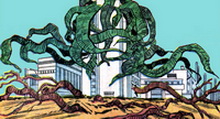 Giant-Man invites reporters to Pym’s lab to tell them how he, Giant-Man, stopped the giant plant. (Oh yeah, there’s this giant plant, menacing all of New York, but I haven’t mentioned it till now, because it’s the least interesting aspect of the story.)
Giant-Man invites reporters to Pym’s lab to tell them how he, Giant-Man, stopped the giant plant. (Oh yeah, there’s this giant plant, menacing all of New York, but I haven’t mentioned it till now, because it’s the least interesting aspect of the story.)
We don’t see it, but don’t you think at some point it might occur to one of these reporters to ask, “Hey, where did this giant plant come from? We’re here in the lab of bio-chemist Henry Pym, could there be any chance Pym wreaked havoc on the city by letting one of his experiments get out of control? And if that’s the case, maybe PYM should be held accountable for his actions?”
And do you think it might occur to any of these ace reporters to question WHY Giant-Man calls a press conference in Pym’s lab? Are none of them going to connect the dots? Or, is Giant-Man right in assuming none of them have enough brains to figure it out?
Or, perhaps he simply sprayed them all with his memory loss serum, selectively wiping their memories of only those things he no longer wishes them to recall.
Wow. It’s awfully convenient to have superpowers and super-potions. Seems Giant-Man can get away with almost anything he wants. I’m not liking him very much in this story.
A FEW WORDS ABOUT THE PICTURES
AND A FEW MORE WORDS ABOUT WORDS
I could go on like this all day, but let’s wrap this up now with a few random observations.
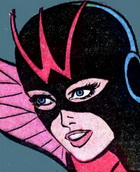 This time around, Giant-Man artist is Carlos Burgos, whom Russ tells me has a history with Marvel Comics, but this is the first time I’m seeing his art, and I especially like what he does with Wasp.
This time around, Giant-Man artist is Carlos Burgos, whom Russ tells me has a history with Marvel Comics, but this is the first time I’m seeing his art, and I especially like what he does with Wasp.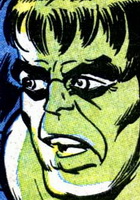 Steve Ditko gives us the art for the Hulk story, and though poor Betty can’t hold a candle to Wasp, I was impressed with the “make-up” Ditko applies to the troubled Hulk, giving him a much more stressed and menacing appearance.
Steve Ditko gives us the art for the Hulk story, and though poor Betty can’t hold a candle to Wasp, I was impressed with the “make-up” Ditko applies to the troubled Hulk, giving him a much more stressed and menacing appearance.- All the Marvel Comics I’m reading are overwritten, but this Giant-Man story tops the list for alliteration. The narrator can’t mention Henry without calling him “happy” or “handsome,” even though those adjectives have nothing to do with the story. Then, when the narrator pops in with an arrow to warn “Look out, Sammy! That ledge isn’t safe!” I feel it’s the writer who’s gone over the edge.
- Oh, and one more thing… on the top of page 17, does General Ross really say “blankity-blank”?? Commander Benson, you’ve been in the military: did your officers talk like that?
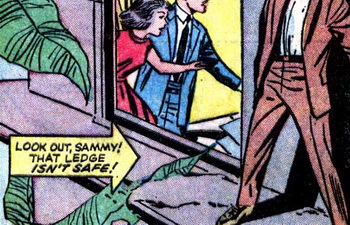
| Want to read this comic on your computer? Marvel has a scan! Want to own the Giant-Man and Wasp story? Buy the Masterworks! Want to own the Hulk story? Buy the Masterworks! |















Or, more likely, they simply haven’t put a dollar’s worth of thought into a 12-cent, 12-page story.
That sentence pretty much sums it up. Your review of this Giant-Man tale, more than any of your previous ones, describes just what was wrong with the series.
It wasn’t the characters. There was nothing inherently wrong with the concept of a super-hero who changes size. And the relationship between Hank and Jan was rife with possibilities. I had no problem with the basic set-up of their relationship (despite the fact that I detest flirty, madcap females [even if they have a core of seriousness deep down] as literary characters and in real life). Their relationship was chock-full of comedic and dramatic potential.
(Also, interestingly enough, in one sense, it was probably Marvel Comics’ most adult relationship at the time. While there may have been a stray mention of Jan living in her own place—I don’t know—it sure seemed like she and Hank lived under the same roof—without, as they used to say, the benefit of marriage. I’m surprised that the Comics Code Authority let Marvel get away with even the suggestion of such a thing.)
Stan Lee didn’t handle the scripting of the Giant-Man series because, I’m guessing, it was too much a conventional super-hero series, and the Smilin’ One had no interest in those. Thus, he turned the art chores over to second-tier freelancers and the writing over to younger brother Larry Lieber, whose stories always seemed to lack inspiration.
Worse, in the case of Giant-Man, there seemed to be a feeling of “Oh, what the hell.” As long as it advanced the plot to the next page. There was no sense of dramatic impart or even “the illusion of change”. Nothing mattered in Giant-Man’s world, except for a single story. Giant-Man’s identity was secret, except when it wasn’t. His costume didn’t give him his super-powers, except when the plot needed it to do so. Hank might invent something which would change the very nature of society, but it was forgotten about by the next issue. Nothing was permanent; nothing lasted; which meant, nothing mattered.
When the talent doesn’t care about the characters, the readers won’t either.
As I stated at the start, there was nothing wrong with the premise of the series, and that’s the pity. You or I or almost anyone reading this could have written better stories than what was produced by Marvel second-stringers at the time.
Commander Benson, you’ve been in the military: did your officers talk like that?
If you’re asking, “Did my officers use terms like ‘blankity-blank’ in place of genuine, paint-peeling curse words?”, the answer is “No.” If you’re asking, “Did my officers curse?”, well, not on social occasions, but “haze-grey and underway”, you were like to hear invectives that were bluer than General Ross’s uniform, when the situation merited it.
There’s a reason for the expression “swearing like a sailor”. I’m as erudite as they come, but if your sensibilities are delicate, you really don’t want to be in earshot if I accidently bang my thumb with a hammer.
Seems Stan was able to come up with compelling ongoing dramatic elements for the FF (Ben Grimm’s angst at his transformation, Sue Storm being torn between feelings for Reed and Namor), Spider-Man (a brilliant but immature teen with a big chip on his shoulder as well as a guilt complex dealing with confused romantic feelings, initially for Liz Allen and then for Betty Brant; his frail aunt, his obnoxious boss, and his classmate who bullies his civilian identity but idolizes his costumed identity); Thor (a mighty god who loves a mortal woman but is chastised by his own father for doing so and is constantly bedeviled by his own brother); Iron Man (a rich industrialist playboy isolated by his heart condition which forces him to wear a big chunk of iron around his chest at all times and is caught up in odd romantic triangle with his personal assistant and chauffeur who also happen to be his closest confidants — for a playboy, Tony Stark, post near-fatal accident, isn’t shown having much of a social life); and in the Avengers, after the big change of issue #16, we have Cap left to transform 3 young former villains into superheroes and two of his new charges look upon him as an old fossil who doesn’t seem to possess any special powers worthy of respect — quite a change from the earlier days when the heroes tended to congratulate one another on how wonderful they all are, aside from when they threw hissy fits about Hank taking advice from ants, but even then they learned to respect those ants! With Giant-Man and Wasp, as well as with the solo Human Torch, neither Stan nor whoever was doing the main writing on the series, could come up with any striking ongoing dramatic element to engage readers and entice them to keep coming back to see what would happen next. While a lot of the Marvel stories of the early ’60s were pretty silly, they generally also had compelling elements and the stories progressively got better in most of the series, with the notable exception of Giant-Man & the Wasp and the Human Torch, which from what I’ve seen were still mostly ridiculous even up to their cancellations in 1965. Stan seriously overhauled the nature of the Marvel Universe in 1965-66, with far more multi-issue stories, greater continuity, etc., apparently to make it more appealing to an older readership, from mostly pre-adolescents to high school or even college age readers. Obviously, he felt neither the GM&TW or HT as series were a good fit in the upgraded M.U. so they had to go, although Johnny was still in the FF and Hank & Jan would shortly re-join the Avengers.
Fred,
Welcome to the Marvelous Zone! Chrissy will be along shortly to reply to your missive, but I wanted to take a moment first to apologize for seemingly butchering your comment. Part of our “schtick” here is that Chrissy is reading these stories for the first time. She has literally no idea what’s coming, the same as readers back in 1964. It helps her maintain the…wonder, and it helps all of us reignite the memories and feelings of what it was like when *we* read them for the first time.
Consequently, I’ve had to edit out a couple of phrases above that would tend to spoil Chrissy on what’s to come. But rest assured, your comments are still there. For those of you who don’t mind being spoiled, just click and drag over the holes in Fred’s comment. All will be revealed.
Hi, Fred! Thanks for your comment. I’ve read as much of it as I can without getting “spoiled” and I agree with you that some of these stories in the 60’s are “pretty silly,” but at the same time, that’s part of what makes them fun to read. I know the tone and format of the stories is likely to change as I keep reading, and I’m actually looking forward to that.
Interestingly, you single out Human Torch and Giant-Man/Wasp as being not in the same class as the other stories, and I think I agree with you. When I first started reading Human Torch, there was a time when I seriously considered just skipping over future stories. Giant-Man and Wasp also don’t seem as substantial, but I do keep coming back for the soap opera! They’re such a fascinating couple!
In fact, Russ has told me that the Hank/Jan relationship is going to develop quite a bit as time goes on…and that’s one thing I’m anxious to find out more about! I just have to find some more time in my days to get back to reading comics more regularly!